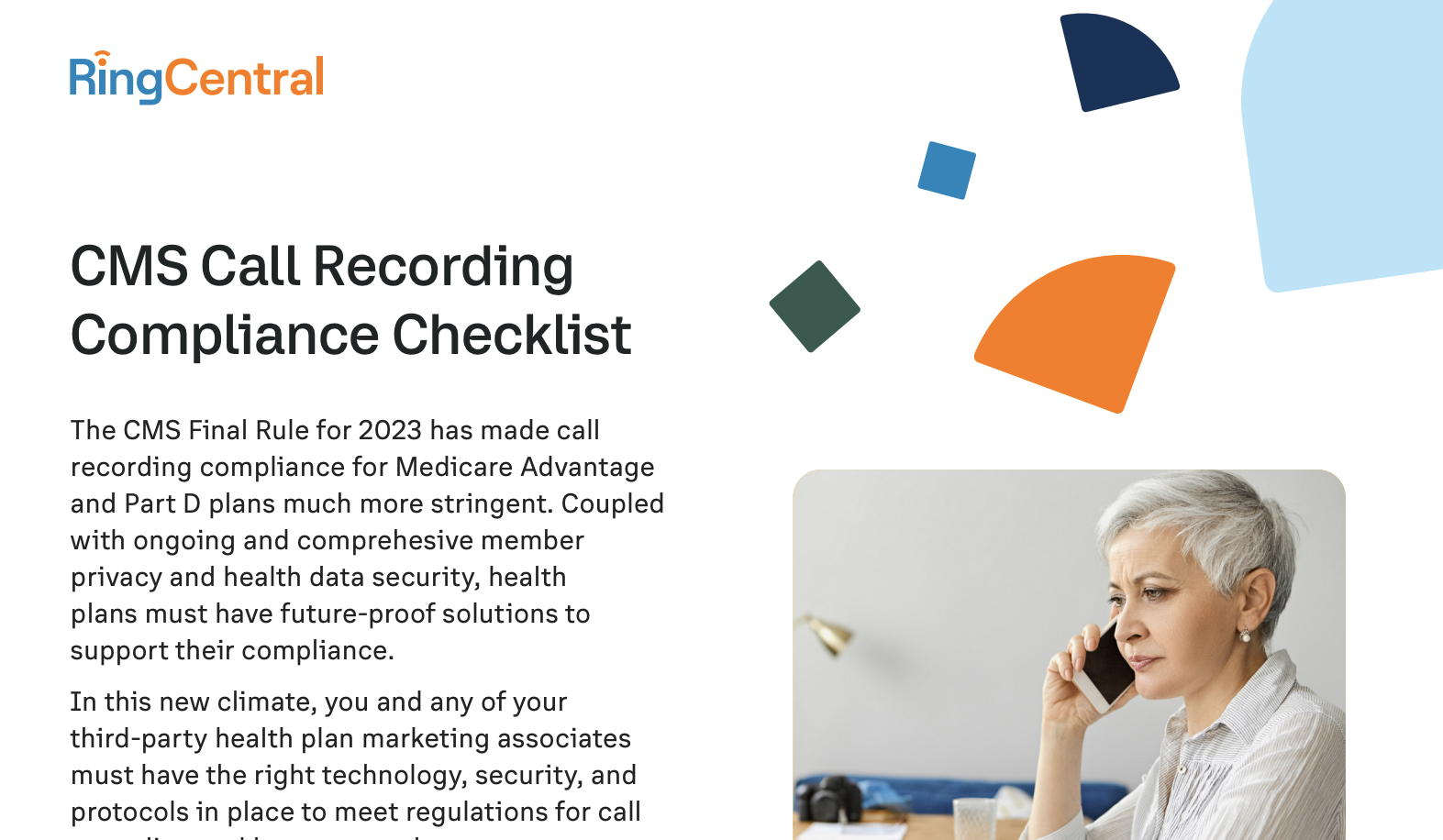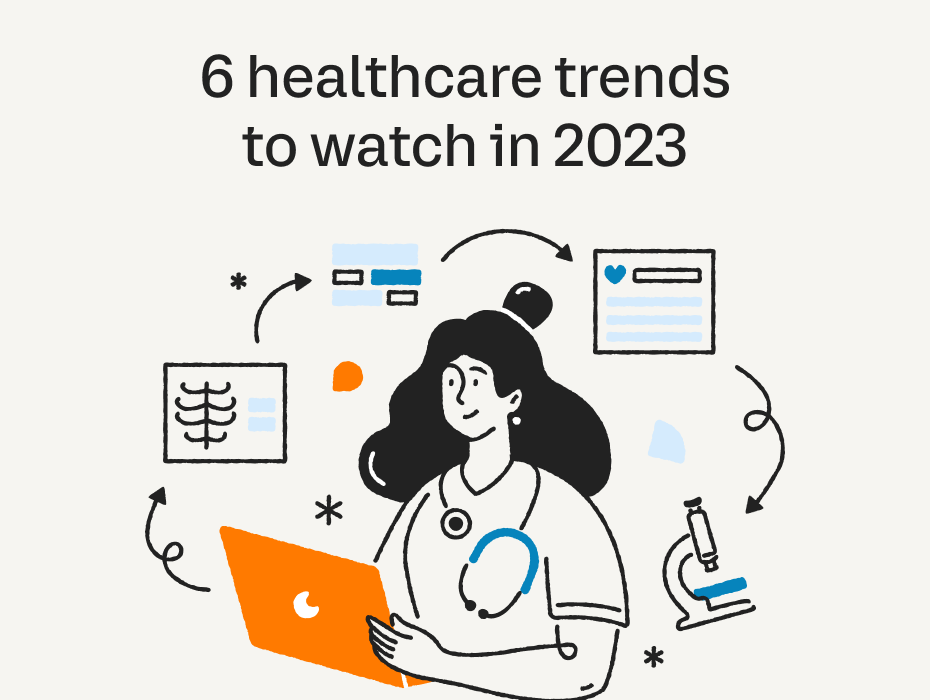‘Tis the season to look ahead at healthcare trends for the year! As you know, the healthcare sector has gone through massive evolution in the last few years. The global pandemic provided a catalyst for the transformation, but the industry has continued to adapt to new trends and technologies.
That’s why key healthcare trends in 2023 center on efforts to streamline communication and other processes in response to health worker shortages and other factors. Let’s look at six of these trends today:
- Continued growth of telehealth services
- More focus on patient experience
- Expansion of artificial intelligence (AI) and digitization
- Escalation of mental health treatments
- More employee-friendly work environments
- Blending the cloud with advanced security
 ✅ Free download: CMS Call Recording Compliance Checklist
✅ Free download: CMS Call Recording Compliance Checklist
6 important healthcare trends to watch in 2023
1. Continued growth in telehealth

It’s hard to believe that pre-COVID, few payers supported telehealth. Now, health plans and providers actively promote this method of care for routine appointments and continuous care.
Growth in telehealth is expected to continue in 2023. This delivery mode is more cost-effective for everyone involved in the health system. It is more convenient and flexible for patients and greatly reduces the number of patient no-shows.
2. More focus on patient experience

Better patient satisfaction: How these healthcare companies did it
Due to rising costs, staff shortages and limited revenue, some hospitals and clinics have closed in the last few years.
For a sustainable, thriving practice, it is essential to prioritize the patient experience to maintain satisfaction. Competition is especially high in large cities where patients have many choices in facilities and providers.
There are many factors that contribute to a strong patient experience, including:
- Personalization. When patients have choices, they choose providers that show genuine interest in their welfare. The best way to do this is with personalized service both in-person and via digital platforms.
- Convenience and accessibility. People want access to convenient locations and alternative methods of accessing health services. Integrating virtual care with your in-office experiences is vital.
- Communication and information. Effective communication and availability of information are critical to patients who have concerns about their health. In a modern healthcare practice, meeting high standards for communication dictates an omnichannel approach that improves patient-to-provide access via web chate, messaging, and other non-traditional touch points. .
- Tech tools and features. A modern website that offers web chat for patients or a secure mobile app are among the essential tech tools patients expect from health providers. A comprehensive patient portal and flexible, self-service options also help address new healthcare consumerism expectations..
3. Expansion of artificial intelligence (AI) and digitization

The healthcare sector has experienced rapid digital progression. Much of the digitization centers on meeting the needs of a remote workforce and patients with restricted mobility.
In addition to patient and employee-centered functions, digitization is being used for research. Artificial intelligence, which has been embedded in many processes, is driving more intuitive patient research. It enables more intelligent analysis of patient interactions across all platforms. It is also being used to capture and share data from clinical trials.
More personal tracking of healthcare via wearable devices
The pandemic spawned greater enthusiasm for remote patient management and supportive self-monitoring of chronic health conditions. Rather than waiting for illness to react, people are more proactive with preventative health measures and self-care adherence.
Wearable devices allow for virtual 24/7 tracking of a variety of data metrics, including:
- Pulse and blood pressure. Tracking basic heart-related data during fitness has long been a popular use of wearable devices. Software applications sync with the device to enable tracking of these metrics throughout the day.
- Sleep effectiveness. Measuring sleep quality is a relatively new phenomenon. People that struggle with insomnia, restlessness, or fatigue monitor sleep patterns to identify potential problems.
- Stress management. Mental health has attracted a lot of attention in the wearable device arena. Mood detection, soothing vibrations, and healing lights are among common strategies used for stress management.
4. Escalation of mental health treatments

Wearable devices aren’t the only platform for increased mental health focus. As we enter 2023, preventative and therapeutic treatments for mental health continue to rise and have made their way onto our healthcare trends list for good reason.
In March 2022, the World Health Organization indicated that COVID-19 triggered a 25-percent spike in anxiety and depression around the world. The sustained trappings of the pandemic left indelible mental and emotional scars for many people. Use of counseling and prescription medications have been among key medical responses, along with various home therapies.
5. More employee-friendly work environments

The “Great Resignation” put a great strain on many healthcare employers. The scramble for talent is one of the factors contributing to competition in the sector. To attract staff, healthcare organizations are developing more flexible work environments for both non-clinical and certain clinical roles.
In addition to various strategies for improving on-site culture, hybrid and remote work opportunities have been maintained. These remote work structures were a response to COVID, but they are desirable for both employees seeking flexibility and employers wanting a larger talent pool.
6. Blending the cloud with advanced security

Reliance on public cloud-based technology has grown the last few years as well. It offers the innovation, flexibility, and security that health organizations need. Digital communications solutions are foundational to internal, cross-organization, and patient-centered communications.
In addition to enabling seamless, cross-channel interactions, robust cloud-based healthcare communications solutions provide multi-factor authentication and end-to-end encryption.
RingCentral for Healthcare: A cutting-edge solution
In reviewing these key 2023 healthcare trends, a common theme is a blend of innovation, communications, and systematic approaches to patient care. To meet this convergence head on, a cloud-based communications solution is key.
RingCentral is an all-in-one, cloud-based communications platform optimized with seamless, cross-channel capabilities and the most advanced cloud-based security protocols available.
See how cloud communications can transform your healthcare organization. Request a demo.
Originally published Jan 30, 2023, updated Feb 02, 2023
Looking For Startup Consultants ?
Call Pursho @ 0731-6725516
Telegram Group One Must Follow :
For Startups: https://t.me/daily_business_reads




